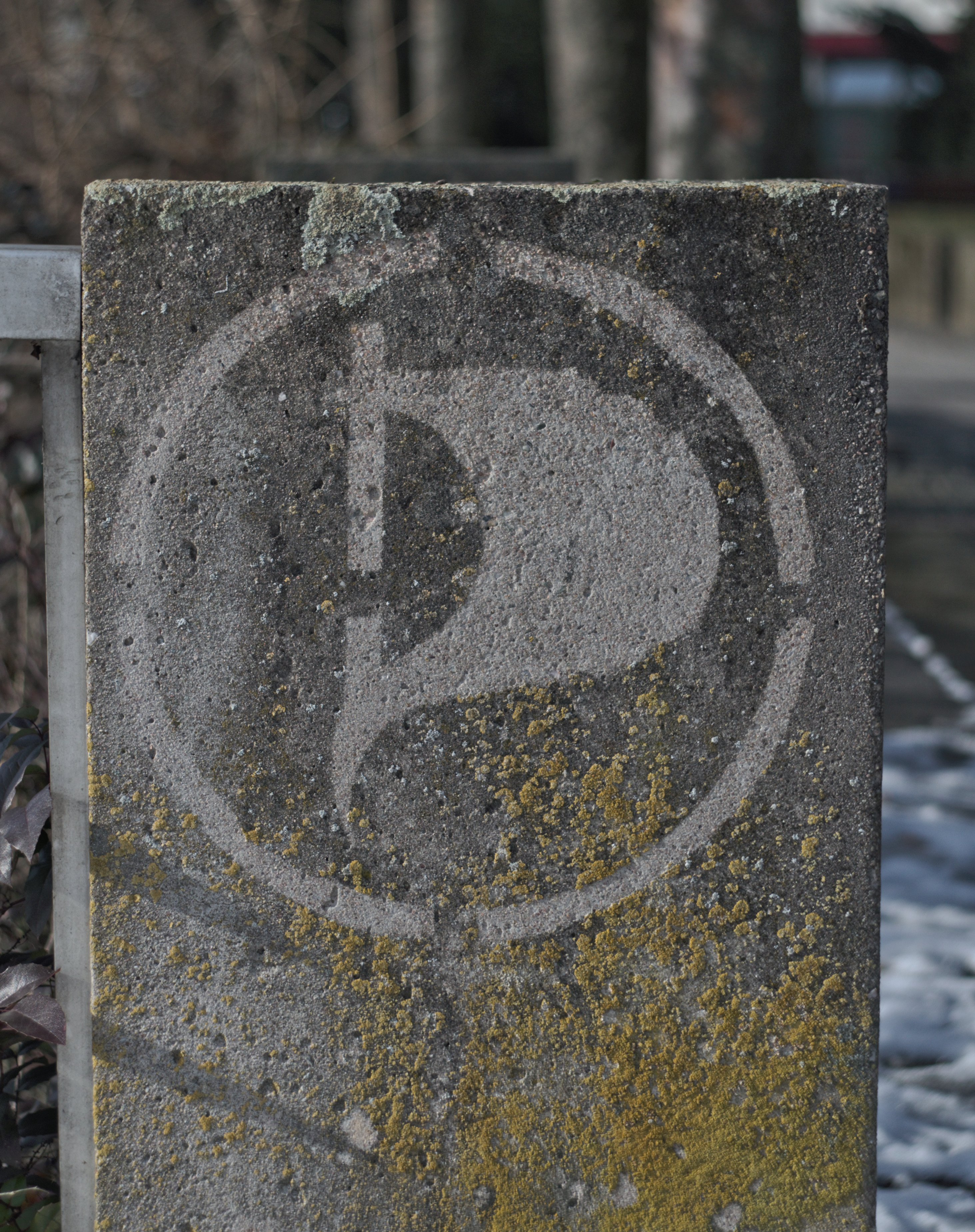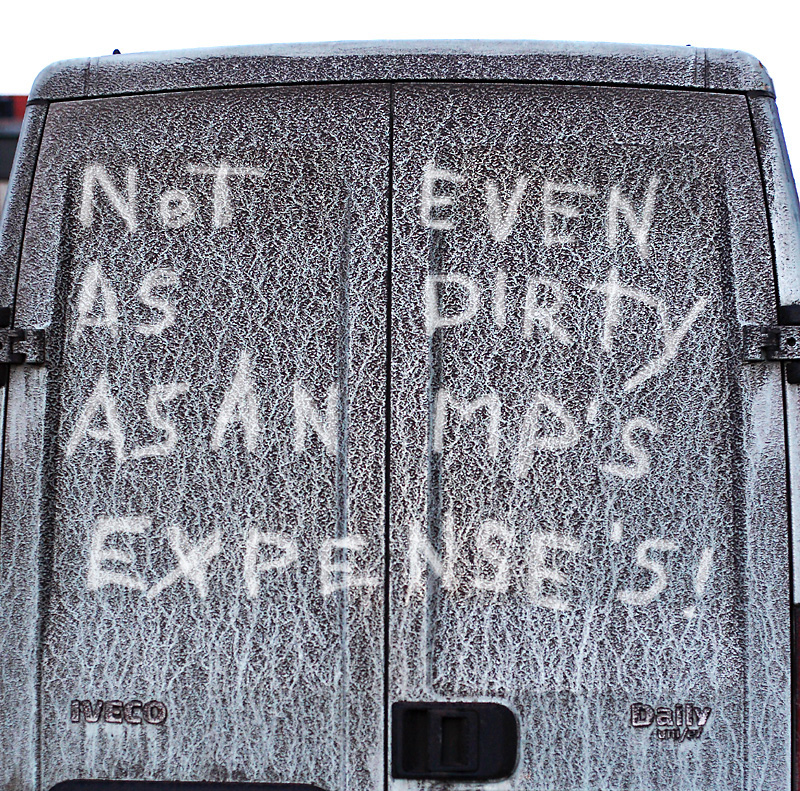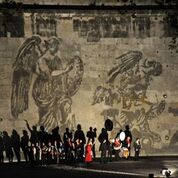Reverse Graffiti on:
[Wikipedia]
[Google]
[Amazon]
 Reverse graffiti is a method of creating temporary or semi-permanent images on walls or other surfaces by removing dirt from a surface. It can also be done by simply removing dirt with the fingertip from windows or other dirty surfaces, such as writing "wash me" on a dirty vehicle. Others, such as graffiti artist
Reverse graffiti is a method of creating temporary or semi-permanent images on walls or other surfaces by removing dirt from a surface. It can also be done by simply removing dirt with the fingertip from windows or other dirty surfaces, such as writing "wash me" on a dirty vehicle. Others, such as graffiti artist

 English artist Paul Curtis (aka
English artist Paul Curtis (aka

 Reverse graffiti is a method of creating temporary or semi-permanent images on walls or other surfaces by removing dirt from a surface. It can also be done by simply removing dirt with the fingertip from windows or other dirty surfaces, such as writing "wash me" on a dirty vehicle. Others, such as graffiti artist
Reverse graffiti is a method of creating temporary or semi-permanent images on walls or other surfaces by removing dirt from a surface. It can also be done by simply removing dirt with the fingertip from windows or other dirty surfaces, such as writing "wash me" on a dirty vehicle. Others, such as graffiti artist Moose
The moose (in North America) or elk (in Eurasia) (''Alces alces'') is a member of the New World deer subfamily and is the only species in the genus ''Alces''. It is the largest and heaviest extant species in the deer family. Most adult ma ...
, use a cloth or a high-power washer to remove dirt on a larger scale.
Reverse graffiti has been used as a form of advertising, although this usage has been controversial, as its legality varies depending on jurisdiction.
Origin

 English artist Paul Curtis (aka
English artist Paul Curtis (aka Moose
The moose (in North America) or elk (in Eurasia) (''Alces alces'') is a member of the New World deer subfamily and is the only species in the genus ''Alces''. It is the largest and heaviest extant species in the deer family. Most adult ma ...
) is one of the first street art
Street art is visual art created in public locations for public visibility. It has been associated with the terms "independent art", "post-graffiti", "neo-graffiti" and guerrilla art.
Street art has evolved from the early forms of defiant graf ...
ists to make an art piece using the reverse graffiti technique. Moose discovered the technique while washing dishes at his restaurant job; he attempted to wipe a mark from the wall only to discover that the wall was actually white and the brown stain was from nicotine smoke. From there, Paul 'Moose' Curtis began his career in the music industry eventually going on to manage a record label. The technique gained traction once Moose began promoting an album for his record label in Leeds, England.
Moose ran into some legal trouble with the British Council, who couldn't decide if reverse graffiti was actually illegal. However, this run in with the law only allowed the medium to reach a bigger platform.
Regarding reverse graffiti, Paul 'Moose' Curtis had said: “I felt like I created this really curious process that flipped the laws and made it really awkward for the legal system to deal with... it was just in a beautiful gray area..."
The first large-scale reverse graffiti art piece was made by Alexandre Orion in 2006. The intervention was called Ossario (ossuary
An ossuary is a chest, box, building, well, or site made to serve as the final resting place of human skeletal remains. They are frequently used where burial space is scarce. A body is first buried in a temporary grave, then after some years the ...
) and was over 1000 feet long. The municipality of São Paulo
São Paulo (, ; Portuguese for ' Saint Paul') is the most populous city in Brazil, and is the capital of the state of São Paulo, the most populous and wealthiest Brazilian state, located in the country's Southeast Region. Listed by the GaW ...
washed it away on July 26.
Environmental Effects
Reverse graffiti is a subtractive process, most often 'cleaning' dirt and pollution from public areas to leave behind messages and/or art pieces. The process has also been linked to the term 'reverse-pollution' literally describes the process of undoing or cleaning pollution caused by human interaction. Artists like Moose and Jim Bowes of GreenGraffiti make sure to keep sustainability at the forefront of their work. It is estimated that one 55-inch square requires 4-5 gallons of water to create an impression; this is around thirty times less than is needed to produce a paper poster of comparable size. GreenGraffiti also adopted a program where they match every liter used in reverse graffiti with a liter of clean drinking water to a drought-stricken region.Process
There are a few different ways to approach reverse graffiti. It most often starts with a stencil created by the artist. Stencils are made of plastic, steel, aluminum, and/or wood. Stencil designs can be laser cut or cut by hand. Artists use power washers, rags, and even toothbrushes. Power washers are the most common technique used among commissioned artists as they are the fastest and most efficient choice to cover large areas. Rags and small brushes can be used to wipe away dust (often on cars or windows) or other lightly dirty surfaces. In some videos, artists can be seen using toothbrushes and concrete cleaner to scrub out smaller messages or pictures.
Commercial
As with traditionalgraffiti
Graffiti (plural; singular ''graffiti'' or ''graffito'', the latter rarely used except in archeology) is art that is written, painted or drawn on a wall or other surface, usually without permission and within public view. Graffiti ranges from s ...
, the technique is also used commercially as a form of out-of-home advertising
Out-of-home (OOH) advertising, also called outdoor advertising, outdoor media, and out-of-home media, is advertising experienced outside of the home. This includes billboards, wallscapes, and posters seen while "on the go". It also includes pl ...
. In this context, marketers call it "clean advertising" or "clean graffiti".
Reverse graffiti has been described by promoters as an environmentally friendly form of advertising, since it is temporary, and can sometimes be done with innocuous or biodegradable materials.
''GreenGraffiti,'' founded by Jim Bowes, is one of the first firms to employ for the purposes of using reverse graffiti for publicity. Bowes' company now has licensing agreements in more than 10 countries. Domino's Pizza
Domino's Pizza, Inc., trading as Domino's, is an American multinational pizza restaurant chain founded in 1960 and led by CEO Russell Weiner. The corporation is Delaware domiciled and headquartered at the Domino's Farms Office Park in Ann Arbor ...
was one of the earliest companies to commission GreenGraffiti; the company invested $20,000 and they reported an estimated $1 million worth of publicity gained.
Companies such as Microsoft
Microsoft Corporation is an American multinational technology corporation producing computer software, consumer electronics, personal computers, and related services headquartered at the Microsoft Redmond campus located in Redmond, Washi ...
, Channel 4
Channel 4 is a British free-to-air public broadcast television network operated by the state-owned Channel Four Television Corporation. It began its transmission on 2 November 1982 and was established to provide a fourth television service ...
and Smirnoff
Smirnoff (; ) is a brand of vodka owned and produced by the British company Diageo. The Smirnoff brand began with a vodka distillery founded in Moscow by Pyotr Arsenievich Smirnov (1831–1898). It is distributed in 130 countries. Smirnoff prod ...
have advertised their products in this way. In response to Moose's use of the technique for advertising in Leeds
Leeds () is a city and the administrative centre of the City of Leeds district in West Yorkshire, England. It is built around the River Aire and is in the eastern foothills of the Pennines. It is also the third-largest settlement (by popul ...
, a city council representative described the work as "illegal advertising". Leeds council later attempted a 12-month trial program allowing clean advertising in exchange for a percentage of fees. The program was criticised by local officials. In 2011, a Swindon
Swindon () is a town and unitary authority with borough status in Wiltshire, England. As of the 2021 Census, the population of Swindon was 201,669, making it the largest town in the county. The Swindon unitary authority area had a population ...
, UK advertising firm was fined by the city's council for a reverse graffiti campaign.
In the Netherlands
)
, anthem = ( en, "William of Nassau")
, image_map =
, map_caption =
, subdivision_type = Sovereign state
, subdivision_name = Kingdom of the Netherlands
, established_title = Before independence
, established_date = Spanish Netherl ...
one needs to have a permit for commercial advertisements in a public space even if nothing is being destroyed.
In Hungary under the name "inverz graffiti" companies and brands like The Coca-Cola Company
The Coca-Cola Company is an American multinational beverage corporation founded in 1892, best known as the producer of Coca-Cola. The Coca-Cola Company also manufactures, sells, and markets other non-alcoholic beverage concentrates and syrups ...
with "It's Rite" for Sprite, Monster
A monster is a type of fictional creature found in horror, fantasy, science fiction, folklore, mythology and religion. Monsters are very often depicted as dangerous and aggressive with a strange, grotesque appearance that causes terror and fe ...
, Deutsche Telekom
Deutsche Telekom AG (; short form often just Telekom, DTAG or DT; stylised as ·T·) is a German telecommunications company that is headquartered in Bonn and is the largest telecommunications provider in Europe by revenue. Deutsche Telekom was ...
's local arm Magyar Telekom
Magyar Telekom Nyrt. (officially ''Magyar Telekom Távközlési Nyilvánosan Működő Részvénytársaság, Magyar Telekom Telecommunications Public Limited Company'' ) is the leading Hungarian telecommunications service provider company. I ...
, Manpower
Human resources (HR) is the set of people who make up the workforce of an organization, business sector, industry, or economy. A narrower concept is human capital, the knowledge and skills which the individuals command. Similar terms includ ...
, Ringier
Ringier AG is a media group in Switzerland, founded in 1833 in Zofingen and based in Zürich. The current strategy is based not only on media but also on e-commerce and entertainment. It has a yearly income of approximately 1000 million CHF an ...
publishing house for launching its Népsport blogging platform, TUC advertised with this tool. Note
See also
* Glossary of graffiti * List of street artists * * * *References
{{DEFAULTSORT:Reverse Graffiti Graffiti and unauthorised signage